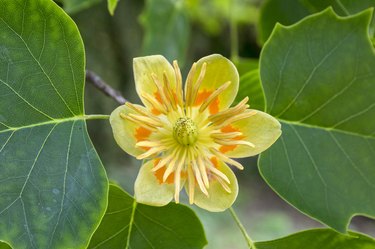
Native to Eastern North America, the tulip tree (Liriodendron tulipifera) is one of the largest trees in the country. It is the state tree of Kentucky, Indiana and Tennessee. As its name suggests, the blooms of this tree are tuliplike in their shape. Hardy in U.S. Department of Agriculture plant hardiness zones 4 to 9, tulip trees usually flower in late spring and early summer, though it can take a long time for them to bloom for the first time.
Tulip Tree Facts
Video of the Day
The tulip tree is a massive tree in the magnolia family. This fast-growing species typically reaches heights between 70 and 90 feet with a canopy that spreads between 30 and 50 feet and has a pyramidal or conical shape. The trunk of the tree is 4 to 6 inches wide. The tulip tree is a great shade tree. The wood of the tulip tree is weak, so it is not unusual for branches to break when weighed down by snow and ice.
Video of the Day
In addition to the standard tree, there are several tulip tree cultivars from which to choose. The upright tulip tree is shorter than the standard version, reaching heights of up to 50 feet, and is also narrower, with spreads of approximately 15 feet. The 'Little Volunteer' tulip tree is a dwarf version with heights between 30 and 35 feet and spreads between 8 and 12 feet.
Tulip Tree Flowering Time
The flowers of the tulip tree are cup-shaped, hence the tree's name. The flowers are greenish-yellow with a visible orange band at the base. A tulip tree will not produce flowers until it is at least 15 years old.
Once it reaches blooming age, a tulip tree produces flowers in May and June. Each flower is between 1.5 and 2 inches in diameter. The flowers can be easy to miss despite their size because they emerge after the leaves of the tree have reached their maximum width of 8 inches and appear at the top of the tree. Even though tulip trees are done flowering after May and June, they turn a dazzling golden yellow in the fall.
Caring for a Tulip Tree
Tulip trees perform best in full sun, which means six hours of sunlight a day at a minimum, though it can handle part shade, which is equivalent to just four hours of sun a day. This type of tree likes soil that is slightly acidic, but it can handle alkaline soils. Good drainage is a must. Because of its fleshy taproot, spring is considered the best time to transplant a tulip tree.
Tulip trees can become infested with pests, such as aphids, which are small insects with soft bodies that congregate on the underside of leaves, where they suck out the sap. Aphids produce a substance called honeydew that breeds a fungus known as black sooty mold that can ruin the plant's appearance. A stream of water from a hose can help remove aphids from the leaves of the trees. Spider mites can also be a problem with tulip trees, as can diseases such as verticillium wilt and canker.